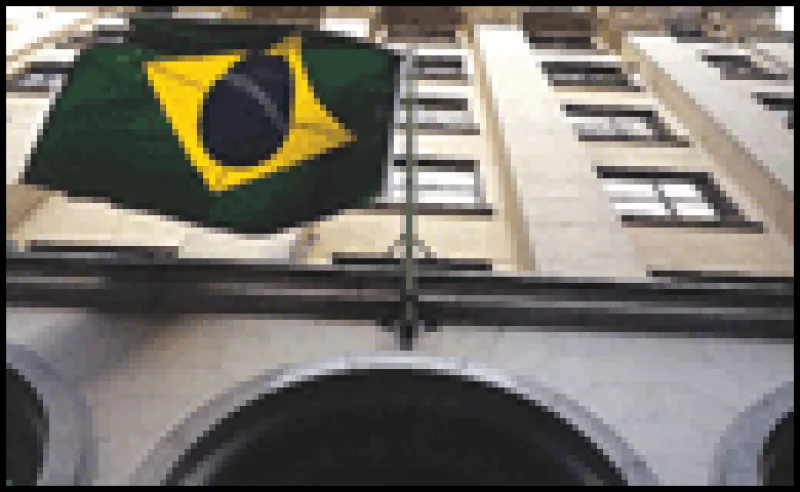Market indices have multiplied in the past years, offering investors hundreds of different ways to measure their returns. Why so many?
| The Bovespa: On the cutting edge. |
Besides the ISE and the ITAG, the Bovespa has also developed a series of indices to complement its benchmark Ibovespa index, which tracks 80% of the stocks traded on the Bovespa. The Ibovespa is rebalanced every four months based on the average market capitalization of the previous 12 months. In September the Ibovespa comprised 57 stocks from 49 companies.
The Bovespa's IBX-100 and IBX-50 indices track the 100 and 50 most-traded shares weighted by their free float. Additionally, just like many exchanges around the world, the Bovespa has dedicated specialized indices for certain industry sectors. Its IEE index tracks 12 electric utility stocks and the ITU index tracks 23 telecom shares.
Working with Valor Econômico, the São Paulo business daily, in 2001 the Bovespa also created the IVBX-2 index to track less familiar, but still fairly liquid, stocks such as Brasil Telecom, Eletropaulo, and Embraer. "The IVBX-2 is made up of 50 stocks, ranked by liquidity, excluding the 10 most liquid companies and the 10 largest firms in terms of market capitalization," says Neuris Vojciechovski, supervisor of market research at Bovespa. "Valor wanted to measure 'second tier' companies." The higher risk of smaller-capitalized companies is rewarded with a higher return, more than double that of the Bovespa since the IVBX-2 launched.
The Bovespa also has developed what Vojciechovski describes as "qualitative" indices – such as the sustainability index or the IGC, the corporate governance index. The IGC, created in 2001, tracks all companies that list on the Bovespa's Novo Mercado, a growing section of the main stock market that is reserved for companies – 17 so far – that meet strict corporate governance and liquidity requirements. Most Novo Mercado companies have listed since 2004, but the Bovespa also offers less demanding Level 1 and Level 2 categories for established companies unable to radically overhaul their governance structures. The IGC index is weighted by market value and is multiplied by a value representing each company's corporate governance category. Novo Mercado companies carry a double weight in the index, Level 2 companies one-and-one-half times, and Level 1 companies are counted once. "The purpose of this index is to see if there is a connection between good governance and performance," says Vojciechovski. There certainly is. Since the IGC index was launched in mid-2001, it has returned 229%, outperforming the Bovespa by 70 percentage points. In response to constant shareholder complaints about inadequate minority rights in Latin America, in June the Bovespa launched yet another index, the ITAG, to track the performance of companies that offer enhanced shareholder rights. The 44 companies included in the ITAG give investors tag-along rights in a takeover at 80% of the price offered to controlling stakeholders, higher than the 60% mandated by Brazilian law. ITAG has increased 32% since then, better than the Ibovespa in the same period.
The most recent addition to the Bovespa's stable of indices is the ISE, tracking the 40 companies that best meet sustainable business criteria, weighted according to their free float. The Bovespa drew up the criteria in consultation with a variety of groups, including the International Finance Corp., the private-sector arm of the World Bank, the Brazilian Environment Ministry, and the National Pension Fund Association.
How It All Began
Investment banks and stock exchanges are always devising new and increasingly complex indices, allowing investors to track the development of new market segments and gain exposure to them. Indices are also an important way to track the performance of managers who earn significant fees to handle client money.
Investors' fascination with emerging-market indices started with the creation of the JP Morgan Emerging Markets Bond Index, or EMBI, which has become the benchmark of benchmarks for fixed-income investors. It was introduced in 1992 just as investors began growing more and more excited over the promise of big profits in the developing world. "Ten to 15 years ago, people didn't know what 'emerging markets' were. The EMBI defined the asset class," says Gloria Kim, vice president at JP Morgan in charge of the Emerging Markets Bond Index Group. The EMBI gives investors and market observers an instant read on how each of the emerging markets are doing.
But dollar-denominated sovereign credits are no longer the headline credits in the emerging-market fixed income market. The new fad is local currency global and domestic markets issues that have attracted investors desperate for yield. The Brazilian government's $1.5 billion equivalent, 10-year real-denominated global bond issued in September shows how fast sovereigns have shifted from hard-currency to local-currency issuance as yield-starved investors show appetite for currency risk. The Brazil local-currency bond is yielding 12.5% compared with 7.3% for the 10-year dollar bond issued in June. Additionally, investors are looking at corporate bonds. The region's largest corporate issuers, such as Mexican cement giant Cemex, Brazilian mining company CVRD, or Chilean copper miner
Codelco, are becoming increasingly larger parts of fixed-income portfolios.
As markets change, so new indices appear. In June, JP Morgan launched its new Government Bond Index-Emerging Markets (GBI-EM), in response to investor demand for global local currency bonds. In emerging markets, hedge funds have become a force driving the market, and Lehman Brothers, Standard & Poors, and Credit Suisse First Boston among others have all unveiled indices to track hedge funds. Wall Street investment banks are looking into launching emerging-market corporate bond indices starting next year. Such an index would reflect the maturity of emerging markets and the rise of several Latin American corporates as global competitors in a variety of sectors.
But not all investors are convinced that these indices will catch on as the EMBI or the São Paulo indices have. "These are being rolled out at a time that emerging markets are doing well," says Andrew Feltus, manager of the global high yield fund at Pioneer Investment Management. "But local currency [issues] perform worse during times of crisis." Feltus thinks that the true test of whether these new indices will become benchmarks will come when the market turns and investors are no longer looking at local issues.
Institutional investors use indices primarily as benchmarks to measure the performance of their portfolios and portfolio managers. "We use them to give our clients an idea of how we're doing," says Feltus. "An index represents how other [managers] are investing." JP Morgan's Kim says the GBI-EM was designed to meet a simple need. "If our clients are pitching a local currency instrument [to investors], they need a proxy for performance," she says. Nick Gendron, global head of index products at Lehman Brothers, notes that investors use indices to track risk. Modeling software allows investors to measure the volatility of a given portfolio against a benchmark index. "Investors need to understand where performance comes from," he says.
But Gendron says investors are also using indices to structure their emerging-market investments. He identifies a transaction called a total return swap as one way in which investors can use an index to enhance the returns of a conservative portfolio. In the swap, the investor exchanges the total return flows from the targeted index for a more vanilla flow, such as a spread over Libor.
| Nick Gendron |
Total return swaps can also be used when investors do not wish to be actively involved in portfolio or risk management on a day-to-day basis. This can be because investors are unfamiliar with the underlying issuer risk in individual bonds or because they do not have a large enough cash amount to be properly diversified. "Let's say you have $40 million you want to invest in a market," says Gendron. "You could buy 10 or 15 bonds but would have lots of issuer risk." Aggressive investors can create more complex tools such as "portable alpha" strategies using indices. Portable alpha is the strategy by which the alpha – a measure of an investment's risk-adjusted performance – and beta – the measure of an asset's risk in relation to the market – are split. The alpha is "ported" to another portfolio using derivatives. For example, an institutional investor could invest in Brazilian equities and sell Ibovespa futures, stripping away the Bovespa beta and leaving the Brazilian equity strategy alpha. This could then be combined with a portfolio, or futures replicating that portfolio, that the investor is more comfortable being exposed to, such as US Treasuries. This allows investors to gain a higher investment return from a less liquid market while limiting exposure to the volatility of that market. But anybody attempting such a strategy might not get the yield they are hoping for. "Portable alpha [proponents] are demanding Libor plus 300 [basis points]," says Feltus. "That's difficult to achieve consistently – I think 200 is risky."
The development of specialized indices complements the growing breadth of the largest indices – Lehman Brothers expects that its Global Aggregate Index, its broadest index of fixed income securities, will cover $1 trillion in managed assets this year. The creation of innovative indices by Bovespa can open the way for other local stock exchanges – such as the Mexico City Stock Exchange and the Buenos Aires Stock Exchange – to spark a greater interest in equity investment.
The Business of Indices
Most investment banks provide indices as part of a research portfolio and do not expect to earn significant revenue off the product. "It's like any research area," says Nick Gendron, global head of index products at Lehman Brothers. "It's adding value, but quantifying that can be tricky." But with high-paid investment bankers on staff to manage these indices – Lehman has nearly 30 people in their index products division – the bottom line quickly becomes important.
JP Morgan, Lehman, and other banks have contracts with third-party vendors such as consultancy securities software firm Wilshire Associates allowing Wilshire to provide index data to investors that are using Wilshire software to manage risk. JP Morgan says it generates a small revenue by providing index data to data vendors, but its main business is trading the underlying securities that are included in the EMBI. And for firms that build indices, there is a lucrative trade in helping institutional investors, such as pension funds, develop new portfolios.
Tracking the Hedge Funds The rise of hedge funds and their outperformance over other more traditional investments is drawing attention. Increasingly, investors are seeking to track these funds and invest in them. Hedge fund indices are sprouting up to meet this interest. Credit Suisse First Boston launched the first asset-weighted hedge fund index two years ago, and Lehman Brothers launched one index-tracking fund in September.
Hedge funds are secretive about their investments and performance, so CSFB teamed up with fund of funds manager Tremont Advisers and Lehman joined up with HedgeFund.net, to provide indices that track the performance of hedge funds. Tremont and HedgeFund.net collect data on the hedge funds and the joint venture uses that data to devise the indices.
One of these indices, the CSFB/Tremont Investable Index, began in August 2003, is rebalanced only semi-annually, priced monthly, and manages to stay liquid by restricting itself to funds with no lock-up period and which are not US-domiciled, among other restrictions. Nick Gendron, global head of index products at Lehman, says his firm only tracks hedge funds that are larger than $25 million in assets. He says the firm can "create slices of the index with higher thresholds than that."
Liquidity is a concern for hedge funds, as they are often small and invested in illiquid instruments. Often it's difficult to change an investment in a fund of funds, and investment banks are offering investments in hedge fund indices as a more liquid alternative. Ultimately, these indices are designed to get investors involved in them. "We want to create a product you can invest in," says Lehman's Gendron, who expects to launch an investable index in 2006.






